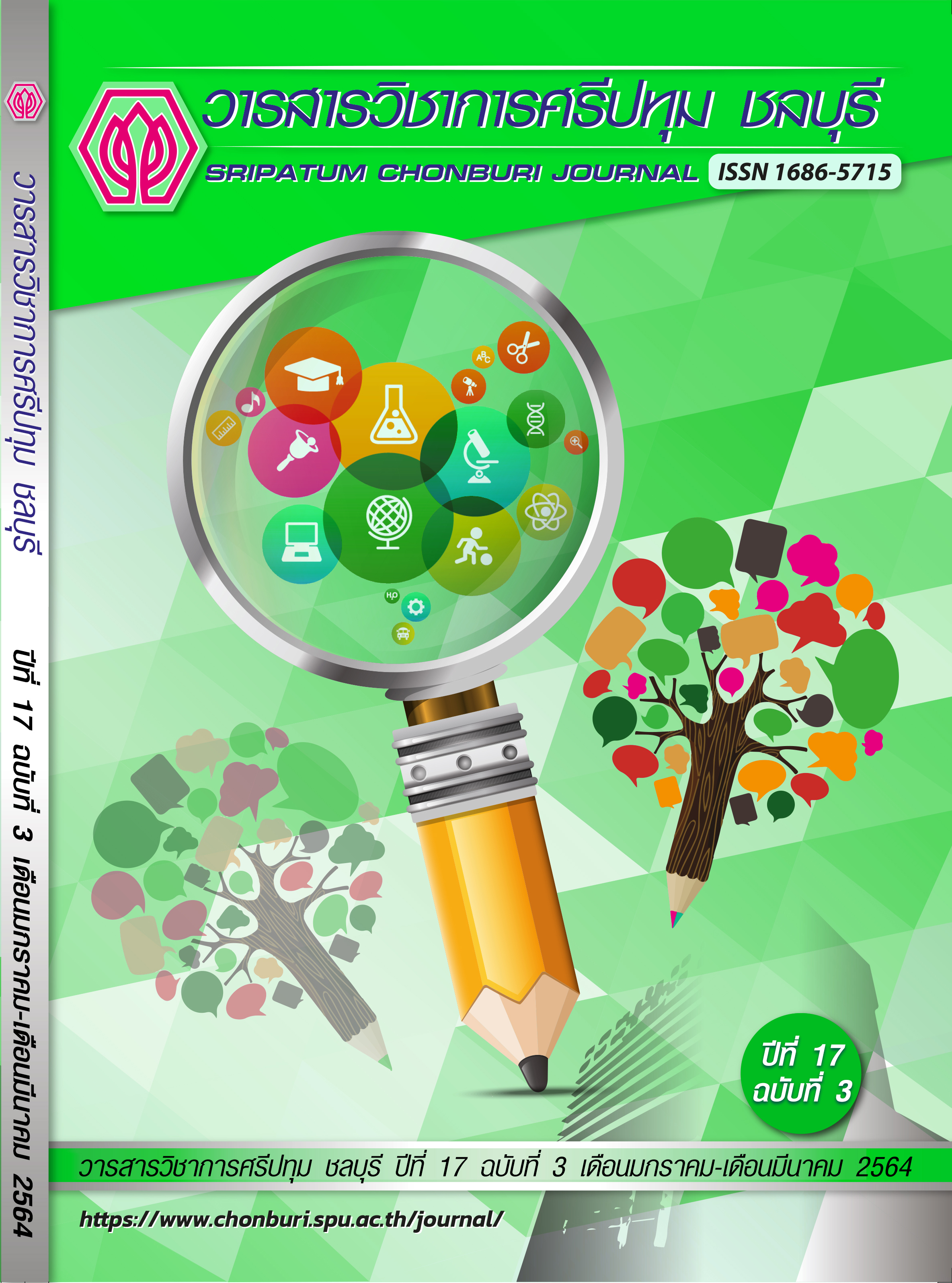THE DEVELOPMENT OF EACDE MODEL LEARNING MANAGEMENT IN RELIGION, MORALITY, AND ETHICS TO PROMOTE DESIRABLE CHARACTERISTICS OF 8TH-GRADE LEARNERS
Keywords:
learning management model, promoting desirable characteristics, 8th-grade learners.Abstract
The purposes of this research were; 1) to study the state of the development of a learning management model in the learning content, religion, morality, and ethics promoting the desirable characteristics for the 8th-grade learners; 2) to develop and find the efficiency of the learning management model, learning content, religion, morality, and ethics that promote desirable characteristics for 8th-grade learners; 3) to compare the learning achievement before and after learning of learners with the learning content, religion, morality, and ethics promoting the desirable characteristics using the EACDE Model; 4) to compare the desirable characteristics of learners by learning contents, religion, morality, and ethics promoting the desirable characteristics using EACDE Model; and 5) to study learners’ satisfaction with the learning management, learning content, religion, morality, and ethics that promoted the desirable characteristics for the 8th-grade learners. The samples were 30 students who were studying in 8th-grade level, class 2/12 of Sikhiu “Sawadphadungwittaya” School. The research instruments were the lesson plan, achievement test, the characteristics development test and the questionnaires. The statistics were percentage, mean, standard deviation and t-test.
The result for the study indicated that the development of a learning management model in the learning content, religion, morality, and ethics promoting the desirable characteristics for the 8th-grade learners, which is a learning process that promotes five desirable features including step 1 the encouragement, step 2 the action, step 3 the conceptualization, step 4 the development of characteristics, and step 5 the evaluation. The efficiency of 8th graders was 82.67/81.58, respectively. The learners have progressed in their studies with higher learning achievement after learning than before with statistical significance at the level of .01. The learners have higher the desirable characteristics of learners after learning than before with statistical significance at the level of .01, and the students were satisfied with the results, found that the development of a learning management Model in the learning content, religion, morality, and ethics promoting the desirable characteristics for the 8th-grade learners at the highest level.
References
ติรยา นามวงษ์. (2561). การพัฒนารูปแบบการจัดการเรียนรู้แบบ SCTAC MODEL เพื่อเสริมสร้างทักษะปฏิบัติและความคิดสร้างสรรค์ สำหรับนักเรียนชั้นมัธยมศึกษาปีที่ 2. วารสารวิชาการแพรวากาฬสินธุ์ มหาวิทยาลัยกาฬสินธุ์, 5(2), หน้า 350-366.
ทิศนา แขมมณี. (2559). ศาสตร์การสอน: องค์ความรู้เพื่อการจัดกระบวนการเรียนรู้ที่มีประสิทธิภาพ (พิมพ์ครั้งที่ 9). กรุงเทพฯ: สำนักพิมพ์แห่งจุฬาลงกรณ์มหาวิทยาลัย.
นิยม กิมานุวัฒน์. (2559). การพัฒนารูปแบบการสอนเพื่อพัฒนากระบวนการคิดเชิงระบบ สำหรับนักเรียนระดับมัธยมศึกษา. วิทยานิพนธ์การศึกษาดุษฎีบัณฑิต สาขาวิชาหลักสูตรและการสอน, คณะศึกษาศาสตร์ มหาวิทยาลัยบูรพา.
นุวัฒน์ อุทารสวัสดิ์. (2561). รูปแบบการพัฒนาคุณลักษณะอันพึงประสงค์ของนักเรียนโรงเรียนบัวใหญ่. วารสารเทคโนโลยีและสื่อสารการศึกษา คณะศึกษาศาสตร์ มหาวิทยาลัยมหาสารคาม, 1(1), หน้า 24-37.
พจมาน ชูสง. (2559). การพัฒนาหนังสืออ่านเพิ่มเติม ชุดเด็กดีวิถีพอเพียง เพื่อยกระดับผลสัมฤทธิ์ทางการเรียน รายวิชาเพิ่มเติมหน้าที่พลเมือง ชั้นประถมศึกษาปีที่ 3. นครศรีธรรมราช: โรงเรียนเทศบาลวัดมเหยงคณ์ สำนักการศึกษา เทศบาลนครนครศรีธรรมราช.
พีรภัทร ฉัตรสุวรรณ. (2555). การพัฒนารูปแบบการจัดการเรียนการสอน กลุ่มสาระสังคมศึกษา ศาสนา และวัฒนธรรม ด้วยศูนย์การเรียนเสมือนเพื่อเสริมสร้างความสามารถการเรียนรู้เป็นทีมของนักเรียนช่วงชั้นที่ 2. วิทยานิพนธ์ครุศาสตรมหาบัณฑิต สาขาวิชาเทคโนโลยีและสื่อสารการศึกษา, คณะครุศาสตร์จุฬาลงกรณ์มหาวิทยาลัย.
มาเรียม นิลพันธุ์. (2555). วิธีการวิจัยทางการศึกษา (พิมพ์ครั้งที่ 6). นครปฐม: โรงพิมพ์มหาวิทยาลัยศิลปากร.
วชิรดล คำศิริรักษ์, อุษา ปราบหงษ์ และถาดทอง ปานศุภวัชร. (2559). การพัฒนารูปแบบกิจกรรมเสริมสร้างคุณลักษณะอันพึงประสงค์สำหรับนักเรียนชั้นมัธยมศึกษาตอนต้น. วารสารมหาวิทยาลัยนครพนม, 6(1), หน้า 97-105.
วิจารณ์ พานิช. (2556). วิถีสร้างการเรียนรู้เพื่อศิษย์ (พิมพ์ครั้งที่ 3). กรุงเทพฯ: ตถาตาพับลิเคชั่น.
_______. (2555). วิถีสร้างการเรียนรู้เพื่อศิษย์ในศตวรรษที่ 21. กรุงเทพฯ: มูลนิธิสดศรี-สฤษดิ์วงศ์.
สํานักงานเลขาธิการสภาการศึกษา. (2550). กระบวนการเรียนรู้เพื่อเสริมสร้างคุณธรรมจริยธรรม (พิมพ์ครั้งที่ 2). กรุงเทพฯ: พริกหวานกราฟฟิค.
อดิศวร์ วงษ์วัง. (2557). การพัฒนารูปแบบการประเมินกิจกรรมส่งเสริมคุณลักษณะที่พึงประสงค์ของนักเรียนมัธยมศึกษาตอนต้น ตามแนวคิดการประเมินแบบทฤษฎีแรงขับ. วิทยานิพนธ์ครุศาสตรดุษฎีบัณฑิต สาขาวิชาการวัดและประเมินผลการศึกษา, คณะครุศาสตร์ จุฬาลงกรณ์มหาวิทยาลัย.
อัจศรา ประเสริฐสิน. (2558). การพัฒนารูปแบบการวัดคุณลักษณะอันพึงประสงค์ 8 ประการ ของนักเรียนระดับชั้นมัธยมศึกษา. กรุงเทพฯ: สํานักทดสอบทางการศึกษาและจิตวิทยา มหาวิทยาลัยศรีนครินทรวิโรฒ.
Clarke, David J., & Hollingsworth, Hilary. (1994). Reconceptualising teacher change. In G. Bell, B. Wright, N. Leeson, & J. Geake (Eds.), Challenges in mathematics education: Constraints on construction, Vol. 1. Proceedings of the 17th annual conference of the Mathematics Education Research Group of Australasia (pp. 153-164). East Lismore, Australia: Southern Cross University.
Dick, Walter, Carey, Lou, & Carey, James O. (2005). The systematic design of instruction (5th ed.). New York, NY: Addison-Wesley.
Elliott, Shannon Snyder. (2007). The GIST model for selection and modification of scientific research for the College Teaching Laboratory based on root competition investigations (Online). Available: http://www.eric.ed.gov/PDFS/ED503776.pdf [2018, December 15].
Gardner, Howard. (2009). Five minds for the future. Boston, MA: Harvard Business Review.
Havighurst, Robert J. (1967). Human development and education. New York, NY: Mckay.
Joyce, B., Weil, M., & Calhoun, E. (2004). Models of teaching (7th ed.). New York, NY: Courtesy of Reece Galleries.
Kemp, Jerrold E. (1985). The instructional design process. New York, NY: Harper & Row.
Kruse, Kevin. (2008). Introduction to instructional design and the ADDIE model (Online). Available: http://www.transformativedesigns.com/id_systems.html [2018, December 15].
Downloads
Published
Issue
Section
License
บทความทุกบทความเป็นลิขสิทธิ์ของวารสารวิชาการศรีปทุม ชลบุรี



